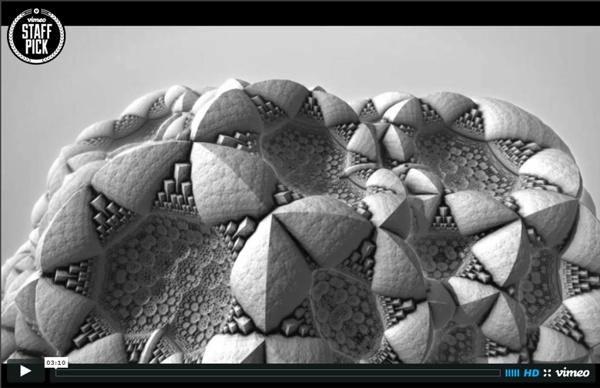



Mandelbulb: The Unravelling of the Real 3D Mandelbrot Fractal Opening Pandora's Box For the Second Time ur story starts with a guy named Rudy Rucker, an American mathematician, computer scientist and science fiction author (and in fact one of the founders of the cyberpunk science-fiction movement). Around 20 years ago, along with other approaches, he first imagined the concept behind the potential 3D Mandelbulb (barring a small mistake in the formula, which nevertheless still can produce very interesting results - see later), and also wrote a short story about the 3D Mandelbrot in 1987 entitled "As Above, So Below" (also see his blog entry and notebook). So the idea slumbered for 20 years until around 2007. Although the second one looks somewhat impressive, and has the appearance of a 3D Mandelbulb very roughly, we would expect the real deal to have a level of detail far exceeding it. Zooming in reveals some interesting detail, but I didn't find a great deal beyond the usual chaos. Full size shown here. Is this merely a fool's quest? WOW!
Fractal Lab - Interactive WebGL Fractal Explorer History Fractal Lab started around the beginning of 2011 as my first explorations rendering fractals in the browser with WebGL. Previously I had created renderers using Adobe PixelBender and QuartzComposer, which both had the advantage of easy integration into Photoshop and AfterEffects but were very limited when it came to interactively exploring the fractal space. Fractals are by nature highly detailed and so the smallest change to an input parameter can often result in dramatic differences in the output shape. In order to properly explore the space (and discover hidden gems that coalesce at specific parameter combinations) I decided to build a new UI (that had to nice to use!), a control system and a new GLSL renderer in WebGL to take advantage of the parallel computing power of the GPU in a web browser. The first version of Fractal Lab was a proof of concept to show that you could modify and fly around the fractals in the browser at interactive speeds. Implementation Ray Marching
Kaleidoscopic (escape time) IFS Hello,Here are some renderings of a class of fractals which I call "Kaleidoscopic IFS". There is a big variations of shapes one can get with this method.I began with this algorithm to get DE for symmetric Sierpinski tetrahedron: Then I added a rotation before the fold or before the stretch or both. //scale=2//bailout=1000sierpinski3(x,y,z){ r=x*x+y*y+z*z; for(i=0;i<10 && r<bailout;i++){ rotate1(x,y,z); if(x+y<0){x1=-y;y=-x;x=x1;} if(x+z<0){x1=-z;z=-x;x=x1;} if(y+z<0){y1=-z;z=-y;y=y1;} rotate2(x,y,z); x=scale*x-(scale-1); y=scale*y-(scale-1); z=scale*z-(scale-1); r=x*x+y*y+z*z; } return (sqrt(r)-2)*scale^(-i);//the estimated distance} Then I allowed the center of stretching to be modified. x=scale*x-CX*(scale-1); y=scale*y-CY*(scale-1); z=scale*z-CZ*(scale-1); r=x*x+y*y+z*z; } return (sqrt(r)-2)*scale^(-i);//the estimated distance} The set of folding operation may be different. if(x+y<0){x1=-y;y=-x;x=x1;} if(x+z<0){x1=-z;z=-x;x=x1;} if(y+z<0){y1=-z;z=-y;y=y1;} - cubic symmetry planes: Ah!
‘Formations’: A SPAN exhibition at the MAK Gallery Architects Matias del Campo and Sandra Manninger, former recipients of MAK-Schindler Scholarships for the Artists and Architects-in-Residence Program in Los Angeles, teamed up in 2003 to found the Viennese studio SPAN, which designed the Austrian Pavilion for Expo 2010 in Shanghai together with Zeytinoglu ZT. The team conceives of architecture as a process and works in the field of applied architectural theory, i.e. at the interface with research. Their projects are centered on future-oriented strategies of designing. These employ medial technologies and involve the development of architectural models from organic systems which are then placed in relation to each other via dynamic spatial programs. For the MAK Gallery, SPAN planned a spatial intervention transferred into a black box. Images and more information on the exhibition after the break. “Formations” is a further highlight in a series of relevant architectural presentations at the MAK Gallery.
Untitled Document Below are some of the projects and programs I've worked on over the years, ones which stick out for some reason. (Oldest items at the bottom, most recent at the top) Botox - O rganic - A7 - BlingBlinging - iBox - D eveloped the iBox . Start Inition ltd - Specialising in graphics related applications and 3D Virtual Reality hardware. Start work for Virtual Presence, specialising in virtual reality real time 3D graphics software and hardware, gain huge experience working with real time 3D vector graphics, PCs, motion tracking systems, HMDs - Head Mounted Displays, 3D input devices. Final year university project - Written in C and OCAM a parallel processing language which ran on the uni's Transputer array with sunny, john and darren. Went to a computer show and got the first glimpse of an Acorn Archimedes, (a real computer) 256 colours and a high res (320x256) colour monitor, 512kb memory, wow. Moved from audio tape storage to 5 1/4 inch disk
3D Mandelbulb Fractal Ray Tracer This implementation was written as a Pixel Bender filter then ported over to QuartzComposer as a GLSL patch to enable animation. The scripts run on the GPU which makes real-time interactive exploration possible. For more information behind the discovery of the Mandelbulb see the accompanying blog post. More images in the gallery and on Flickr. Animation Animations can be created in Adobe After Effects using the .pbk files, but it will be very slow to render as the calculations have to be performed on the CPU rather than the GPU. Download and installation Download the 3D Mandelbulb Ray Tracer Note: there are two versions of each filter, the quick and and the normal. For Pixel Bender open the Mandelbulb.pbk file with the Adobe Pixel Bender Toolkit or copy it into the Pixel Bender Files folder in your Photoshop CS4 installation directory (you will need to have installed the PB plugin for Photoshop first). How to use Defining the fractal power: the power n used in the fractal equation. Navigation
Fractals and chaos: the Mandelbrot ...